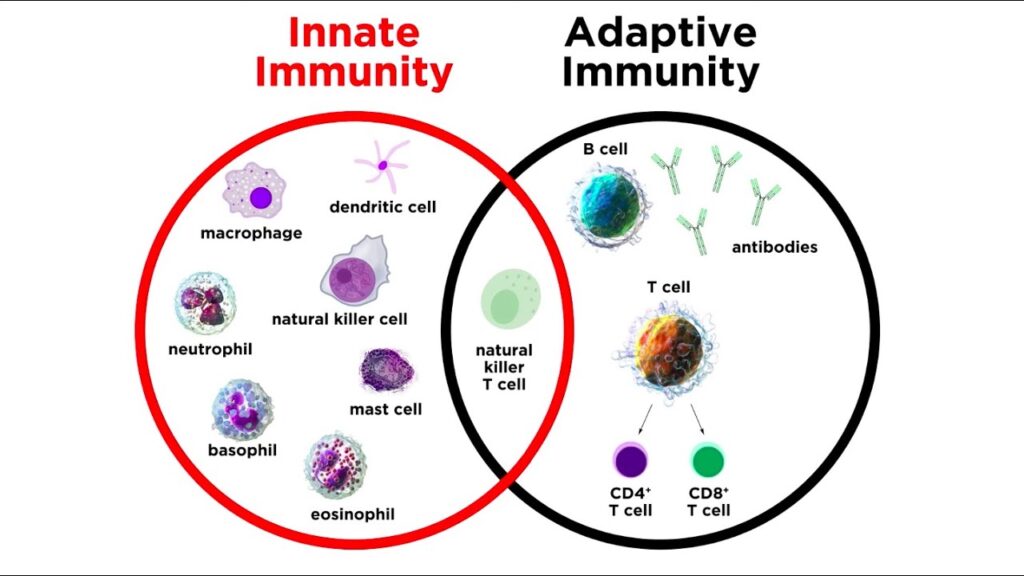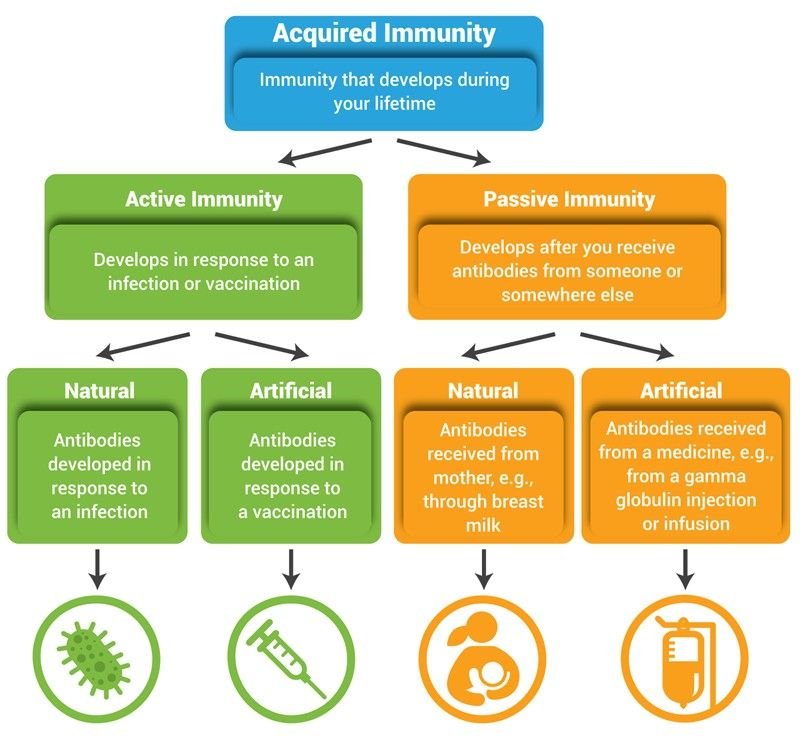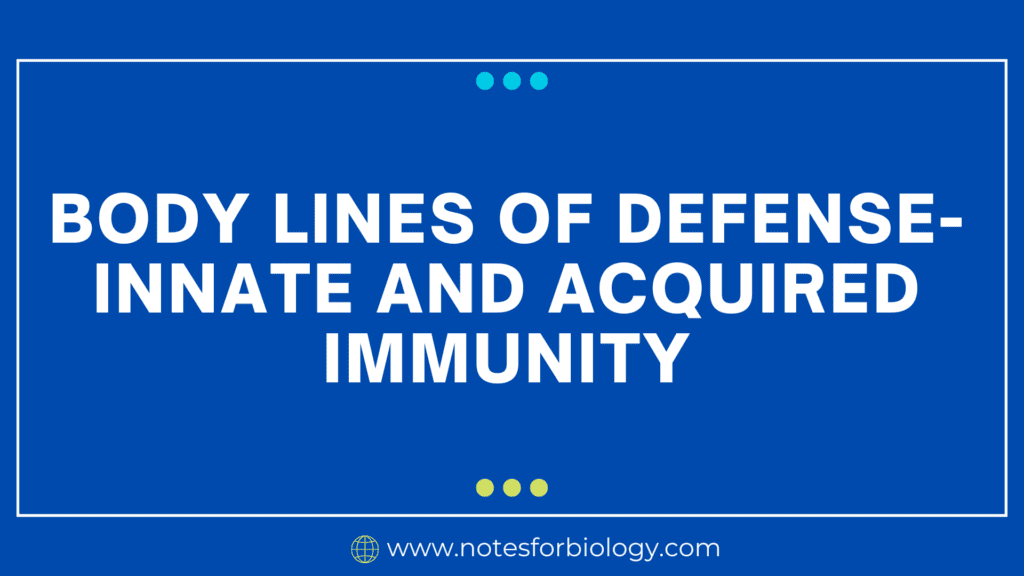acquired immunity and Innate immunity are the two main defensive systems that make up the immune system of the human body. The initial line of defense is innate immunity, which uses phagocytic cells, inflammatory processes, and physical barriers to respond quickly and broadly to a variety of pathogens. On the other hand, acquired immunity takes longer to develop but provides a very focused response that is particular to each pathogen. It involves the production of memory cells that provide long-term protection as well as the activation of B and T lymphocytes. These systems cooperate to keep the body resilient and generally healthy by efficiently recognizing, battling, and remembering dangerous intruders.
The immune system of humans is a sophisticated network that protects the body from dangerous intruders like pathogens (bacteria, viruses, fungus, and parasites). Innate (nonspecific) immunity and acquired (adaptive or specific) immunity are its two main modes of operation.
Table of Contents
Innate Immunity
The initial line of protection, innate immunity reacts quickly to pathogens. It is nonspecific, which means that it offers a broad response rather than focusing on a particular disease.

Components of Innate Immunity
1. Physical and Chemical Barriers
Skin: Serves as a physical defense against the introduction of pathogens.
The genitourinary, gastrointestinal, and respiratory systems are lined by mucous membranes that trap microorganisms.
Secretions: These include stomach acid, tears, and saliva. Lysozyme is one of the enzymes found in secretions that breaks down bacterial cell walls.
2. Cellular Defenses
Phagocytes are pathogen-engulfing, pathogen-digesting cells, similar to neutrophils and macrophages.
Natural Killer (NK) Cells: T lymphocytes that recognize and eliminate malignant and virus-infected cells without the need for previous activation.
Dendritic cells: Serve as antigen-presentation cells in the acquired immune system, presenting pathogen antigens to T cells after processing them.
3. Inflammatory Response
Proteins generated by cells that mediate and control hematopoiesis, inflammation, and immunity are known as cytokines and chemokines.
Complement System: A collection of proteins that improves the pathogen-clearing capacity of phagocytic cells and antibodies.
Acute Phase Proteins: The liver’s production of proteins in reaction to inflammation, such as C-reactive protein (CRP).
4. Physiological Responses
Fever: Boosts immunity and raises body temperature to make the environment less conducive to infections.
Acquired (Adaptive) Immunity
Slower, more focused, and more effective than other defense mechanisms is acquired immunity. Long-lasting immunity is provided by memory cells that are formed and lymphocytes that are activated.

Components of Acquired Immunity
1. Lymphocytes
B-cells: Generate antibodies that attach to particular antigens and neutralize infections or label them so that other immune cells can destroy them.
Differentiated B-cells that generate a lot of antibodies are called plasma cells.
Recall B-Cells: Remain in the body to enable a faster reaction in the event that the same virus is encountered again.
T-cells: Carry out a number of tasks related to adaptive immunity.
B-cells and other T-cells are activated and regulated by helper T-cells (CD4+).
Kill tumor cells and virus-infected cells with cytotoxic T-cells (CD8+).
Regulatory T-Cells: Assist in controlling and inhibiting immunological responses to avert autoimmunity.
2. Antigen Presentation
Major Histocompatibility Complex (MHC): Cells’ molecules that expose T-cells to pieces of antigen.
All nucleated cells have MHC Class I, which presents antigens to cytotoxic T-cells.
MHC Class II: Exposed on helper T-cells and antigen-presenting cells (APCs) such as dendritic cells, macrophages, and B-cells.
3. Humoral Immunity
B-cells produce antibodies, also known as immunoglobulins, which are proteins that attach to antigens precisely to neutralize or flag them for destruction.
The most common antibody, IgG, offers long-term protection.
Mucosal immunity depends on IgA, which is present in mucous membranes.
IgM: The first antibody generated in reaction to an infection.
IgE: Plays a role in allergic responses.
IgD: Mostly acts as a B-cell receptor.
4. Cell-Mediated Immunity
Cytotoxic T-Cells: Identify and eliminate malignant or contaminated cells.
Helper T-Cells: By triggering other immune cells, they help to coordinate the immunological response.
Regulatory T-Cells: Prevent autoimmune reactions and sustain immunological homeostasis.
Interplay Between Innate and Acquired Immunity
Recognition and Reaction: Common pathogen-associated molecular patterns (PAMPs) are recognized by innate immune cells, which then launch a prompt defense. The acquired immune response can be shaped and influenced by this initial reaction.
Antigen Presentation: By processing and presenting pathogen-derived antigens to T cells, dendritic cells and other antigen-presenting cells (APCs) connect the innate and acquired immune systems.
Memory Formation: The acquired immune system creates memory cells following the initial exposure, ensuring a quicker and more potent response on repeated encounters with the same pathogen. In contrast, the innate reaction occurs instantly.
Summary of Innate and Acquired Immunity
While acquired immunity delivers a delayed, highly specific, and long-lasting response to infections, innate immunity offers an instant, nonspecific defense. Together, the two systems keep the body healthy and guard against illnesses.
Frequently Asked Question
1. What are the differences between innate and acquired immunity?
The innate resistance to infections that a person has from birth as a result of their genetic or constitutional makeup is known as innate immunity. The resistance that a person develops or adjusts during their lifetime against infectious foreign substances is known as acquired immunity.
2. What is innate immunity and examples?
The body’s initial immune system reaction to a dangerous foreign material is known as innate immunity. Some immune system cells may react fast to foreign things entering the body, including viruses or bacteria, and attempt to eliminate them.
3. What is acquired immunity examples?
Your immune system becomes more robust with acquired immunity. For example, vaccines introduce trace quantities of microorganisms into your immune system without harming you. Your immune system gains the ability to identify those germs, enabling it to naturally combat them the next time it comes into contact with them.
4. Why is it called innate immunity?
The proteins in your body’s cells are known as antigens. Among these is a class of antigens known as HLA antigens. These antigens become commonplace to your immune system, which means it often doesn’t respond negatively to them. Your innate immunity, also known as nonspecific immunity, is your defense mechanism from birth.
Related Article


